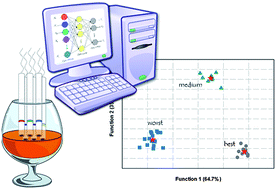This work reports the application of a voltammetric Electronic Tongue (ET) in the analysis of brandies, specifically in their classification according to the scores given by a skilled sensory panel and in the discrimination of different ageing methods. For this purpose, spirits were analyzed with no other pretreatment than their dilution with a saline solution to ensure enough conductivity. Recorded voltammetric signals produced by an array of six modified epoxy-composite sensors were preprocessed employing Fast Fourier Transform in order to reduce the complexity of the input signals while preserving the relevant information. Then, using the obtained coefficients, responses were evaluated using Linear Discriminant Analysis (LDA) as the pattern recognition model used to carry out the classification tasks. In both cases, good prediction ability was attained by the ET (classification rates of 100% and 97%, respectively), therefore permitting the correct classification of the different samples under study. Furthermore, two Artificial Neural Network models were also trained for the semi-quantitative identification of some undesired compound markers of some brandy defects above certain levels (namely butan-2-ol, ethyl acetate, acetaldehyde and butan-1-ol; r > 0.975) and the quantification of polyphenol index I280 (r = 0.977).

You have access to this article
 Please wait while we load your content...
Something went wrong. Try again?
Please wait while we load your content...
Something went wrong. Try again?


 Please wait while we load your content...
Please wait while we load your content...